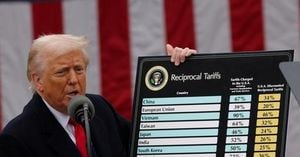On Monday, September 22, 2025, the financial world turned its attention to the United Kingdom as the Bank of England (BoE) held its ground on interest rates, keeping the base rate steady at 4 percent. The decision, which had been widely anticipated by analysts and market watchers, comes at a time of mounting economic uncertainty and persistent inflationary pressures. The Monetary Policy Committee (MPC) voted by a majority of 7–2 to maintain the rate, with two members pushing for a 0.25 percentage point cut, according to reports from multiple sources including Investing.com and Investment Week.
This pause in the BoE’s rate-cutting cycle follows a previous reduction in August 2025, when the base rate was trimmed from 4.25 percent to 4 percent. That move brought the base rate 1.25 percentage points below its peak of 5.25 percent just over a year ago, as the central bank seeks to balance the twin challenges of taming inflation and supporting a sluggish economy. The next key decision is scheduled for November 6, 2025, and the outcome will hinge on fresh inflation data and the broader health of the UK economy.
Bank of England Governor Andrew Bailey and Chief Economist Huw Pill are scheduled to speak this week, and their remarks are being closely monitored for any hints about the future trajectory of interest rates. Bailey signaled last week that while further rate cuts remain on the table, they are likely to proceed at a more unpredictable pace. "Rate cuts should continue, but they would proceed at a more unpredictable pace," Bailey indicated, according to Investing.com. This sentiment captures the cautious stance adopted by the bank as it navigates an increasingly complex economic landscape.
Meanwhile, ING, a major international bank, maintains its expectation for another rate cut in November 2025. Market pricing currently stands at 7 basis points, suggesting that investors are not fully convinced a cut is imminent. ING analysts noted that the EUR/GBP exchange rate has the potential to move higher into the end of the year, particularly if the upcoming November Budget introduces additional volatility. However, for the current week, ING suggests that the EUR/GBP might not climb significantly unless there are major divergences in PMI (Purchasing Managers' Index) data between the UK and the eurozone. The bank cited a "lack of convincing drivers to sell the expensive pound" as a limiting factor for substantial movement in the currency pair.
UK PMI data will also be in sharp focus this week, as markets assess the performance of the economy alongside central bank commentary. These indicators are seen as critical in determining whether the BoE will feel confident enough to resume its rate-cutting path or whether inflationary risks will force it to hold steady for longer.
The BoE’s decision to hold rates at 4 percent has immediate implications for millions of households and savers across the UK. For mortgage borrowers, the news is a mixed bag. As This Is Money explains, most borrowers would have seen little immediate benefit even if rates had been cut, since lenders tend to base their pricing on the longer-term outlook for interest rates rather than reacting to individual base rate decisions. The cheapest two-year fixed mortgage for someone remortgaging with 40 percent equity is currently at 3.81 percent, while the lowest five-year fix stands at 3.88 percent. For a £200,000 mortgage over 25 years, that translates to about £1,035 per month for the two-year fix and £1,088 per month at a 4.29 percent rate.
Chris Sykes, a property finance specialist at MSP Financial Solutions, remarked, "It's no surprise it is a hold and no surprise is generally a good thing for the market as it provides consistency." He noted that mortgage lenders have been pricing in the hold, so rates are unlikely to move much in the short term. Tracker and variable rates, which are directly tied to the BoE base rate, will also remain unchanged for now.
For homebuyers with smaller deposits, major lenders are offering rates just above the 4 percent mark. A 20 percent deposit can secure a rate of 4.02 percent, while a 10 percent deposit brings a rate of 4.29 percent. These figures highlight the continued challenges facing first-time buyers and those looking to move up the housing ladder.
Looking ahead, the future of interest rates will depend heavily on the path of inflation. The Office for National Statistics (ONS) recently reported that consumer price inflation remained stubbornly high at 3.8 percent in August, nearly double the BoE’s 2 percent target. Peter Stimson, director of mortgages at MPowered, warned, "Consumer prices are still rising at nearly double the Bank’s 2 percent target. This heat cauterised any chance of a September base rate cut, and a November base rate cut may be off the cards too." Ravesh Patel, director and senior mortgage consultant at Reside Mortgages, was more optimistic, suggesting that if inflation falls, the BoE might cut rates further than currently forecast.
However, Stimson cautioned that even if further rate cuts do materialize, their impact on mortgage rates may be limited. "Swap rates, which track interest rate expectations and are used by mortgage lenders to determine the fixed interest rates they offer to borrowers, still suggest there will be two more base rate cuts in total, but the timing could now be pushed into next year," he said. "Unfortunately for anyone planning to buy their first home or remortgage in the coming months, these two cuts have already been priced into the interest rates offered by lenders. This means that even when they do come, the remaining base rate cuts are unlikely to make much of a dent on the mortgage interest rates offered to borrowers."
For savers, the outlook is also shifting. While higher base rates generally benefit savers, the best savings rates are now on a downward trajectory. The average easy-access savings rate has dipped below 3 percent, while the best deals currently offer around 4.3 percent. Fixed-rate bonds are faring slightly better, with the top one-year deal paying 4.45 percent, but this is still down from highs of over 6 percent seen in October 2023.
James Blower, founder of The Savings Guru, commented, "Current savings rates are significantly higher than they should be for a 4 percent base rate which is expected to fall to 3.5 percent." If the base rate does drop to 3.5 percent by spring 2026, as markets predict, easy-access rates could fall below 4 percent for the first time since the summer of 2023. Rachel Springall, finance expert at Moneyfacts, advised, "Now is the time for savers to ditch and switch elsewhere, such as to mutuals or challenger banks that are paying attractive rates."
As the BoE continues to tread carefully, both borrowers and savers are left navigating a landscape where certainty is in short supply. With inflation proving stubborn and the economy still searching for momentum, the next few months will be pivotal in shaping the UK’s monetary policy—and the financial fortunes of millions.





